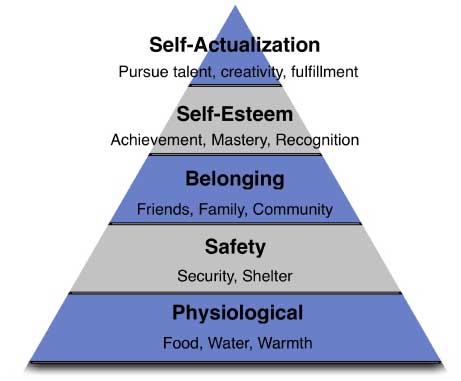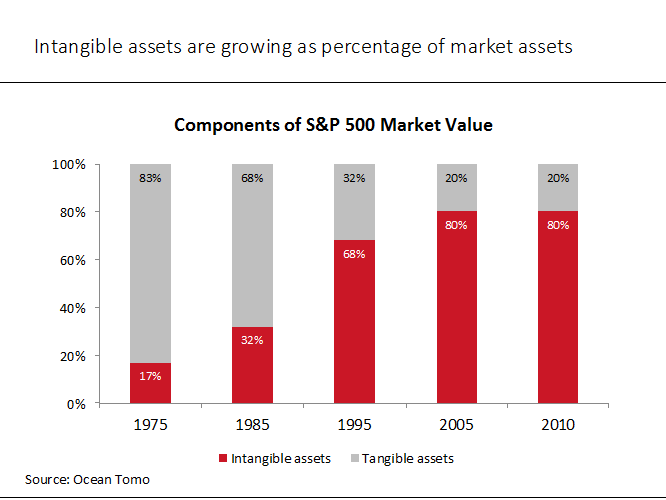Snapchat received a $10 billion valuation this week, joining an ever-increasing number of young IPOs and startup companies that are meeting consumers’ evolving needs to create extraordinary value for investors.
How can Snapchat, Uber and Airbnb be worth so much? An answer to that question may come from an unexpected place. American psychologist Abraham Maslow is best known for his seminal research on the hierarchy of innate human needs, but his work also has a surprising application for businesses models and shareholder value, according to Barry Libert, Jerry Wind and Megan Beck Fenley, who wrote this opinion piece.
In 1943, Abraham Maslow developed his formative work on the hierarchy and progression of human needs, “a theory of psychological health predicated on fulfilling innate human needs in priority, culminating in self-actualization.” Maslow insightfully noted that the human hierarchy of needs spans from the tangible, such as food and water, to the intangible, such as self-esteem and creativity.
Maslow would probably be surprised today to discover that a similar progression can also be observed in the business world. Many firms, enabled by new, digital technologies, are making the shift from providing goods and services — physical things — to providing information and connectivity — intangible things. This shift is already creating ripples of change in finance and financial markets. Companies that serve these higher, more intangible needs of customers are being rewarded by the financial market with higher valuations than those that serve the lower, more tangible needs of customers that include structure and sustenance. Snapchat, Airbnb and Uber are just the tip of the iceberg of $10 billion startups and $100 billion public companies.
The Future of Business and Finance
Put simply, the ways businesses meet the needs of their stakeholders, and the types of needs served, have changed over time along with the development and adoption of new technologies. Together, these needs and enabling technologies create different business models, each with their own scalability, capital and operating efficiencies and, therefore, valuation.
The bottom two levels of Maslow’s hierarchy relate quite closely to the agrarian and industrial revolutions in which large organizations were constructed to fulfill the physiological and safety needs of people. These industries include farming, water, utilities, irrigation, real estate and energy (physiological needs), as well as fire, police and the military (safety needs).
More recently, however, businesses, enabled by a host of new technologies, such as cloud, social and mobile, have begun to serve the intangible needs of human beings which sit at the top levels of Maslow’s hierarchy. These include:
- Belonging: Many companies now exist to facilitate communities. Facebook connects people with their friends, LinkedIn with their colleagues and Match.com with potential mates. There are also many highly specific communities for people dealing with unusual circumstances, such as rare diseases (e.g., RareConnect.org) or unusual hobbies (e.g., ArcheryTalk.com). Many of these communities had not been able to gather and communicate previously.
- Self-esteem: There are also many new ways for people to demonstrate, and be recognized, for their achievements. From the slightly frivolous, “How many likes did my new profile picture get?” to the utilitarian, “How many stars did my most recent Airbnb guest give my apartment?” we are now able to measure our quality and impact in myriad ways.
- Self-actualization: Finally, new organizations are enabling people to express themselves creatively and/or make a living in innovative ways. Instagram allows creative expression through photographs. Etsy gives artisans a forum to share and sell their handiwork. Uber and Airbnb allow people to take control of their careers and to make a living using their resources in a new way.
It is not surprising that businesses have grown in scope to serve these higher order needs, particularly in a world in which the middle class is growing and they have fewer physiological and safety concerns. What is surprising, however, is how dramatically companies and their investors have shifted their capital from tangible, asset-based businesses (aligned with the bottom two needs) to intangible, asset-light organizations (aligned with the top three needs). According to research by Ocean Tomo, in 1975, tangible assets made up 83% of the market value of the S&P 500 companies. By 2010, the numbers had flipped completely, and intangible assets constituted 80% of market/corporate value.
This fundamental change signals something profound about the future of finance and financial markets.
Put simply, the finance function, and generally accepted accounting principles (GAAP), must adapt in order to help organizations measure and manage these new sources value (communities of common interest, self-esteem, self mastery and self-actualization). Accounting practices have not kept pace with the changing asset base of business as well as many key intangible assets. In fact, many higher-order needs of individuals are either mis-measured (lumped into the Goodwill grab bag), or ignored altogether. Human capital, such as employees, is classified as an expense. So are employee training, education and health care. Worse, customers and their relationships are not measured at all. This situation does not serve business leaders well, particularly leaders of large, established companies that are trying to find the right way to develop and use more scalable and capital-efficient intangible resources together with today’s technologies to drive performance and shareholder value. This mismatch provides a large opportunity for accounting firms to help leaders understand these different sources of value and thereby change the landscape for how business is done and governments are run globally.
Helping leaders understand and utilize intangible assets becomes even more urgent when you realize that the financial markets have already adjusted their thinking and capital allocations in favor of these newer, intangibles-based business models that use today’s technologies to scale at zero, or near zero, marginal cost. Our research, conducted by OpenMatters in partnership with Deloitte, looked at 40 years of data from the S&P 500 companies and found that investors are rewarding organizations that satisfy these higher levels of customer needs, such as community, esteem and self-fulfillment, with valuations that are far greater than the organizations that satisfy the lower-order physiological and safety needs.
Our research identified four primary ways that companies create value for their customers:
- Asset Builders that make, market, distribute and sell physical products. Examples include manufacturers (all industries), distributors and retailers.
- Service Providers that hire people who provide services for which customers are charged. Examples include consulting firms, health care providers and financial institutions.
- Technology Creators that develop and sell intellectual property, such as software and biotech. Examples include software and pharmaceutical companies.
- Network Orchestrators that create and manage networks of consumers, businesses or investors to help the participants market and sell their wares on a peer-to-peer basis. Examples include financial trading markets, on-line social networks and credit card processing companies.
The later two business models, Technology Creators and Network Orchestrators, are rewarded by the financial markets (investors) with price to revenue ratios two to four times greater, on average, than Asset Builders and Service Providers due to their focus on highly scalable “intangible assets.”
What Does This Mean for Your Organization?
Simply, this: There is a great shift in value that is occurring globally as organizations climb Maslow’s hierarchy to serve our less tangible needs. In fact, we are just beginning to witness the power of firms that use today’s technologies to fulfill the belonging, self-esteem and self-actualization needs of individuals. From well-known network players like Facebook, Airbnb and Uber, to smaller startups like Behance.com and Spoonflower, to older established companies like GE and AT&T, the market is moving towards intangibles.
All companies have a network of resources in their customers, employees, suppliers, distributors and retailers, and investors. Given this research, how can you make use of these resources in your organization? Begin to climb the hierarchy of needs by following these four steps:
- Orientation: Understand the needs of your networks that you have not fulfilled, including community, self-mastery and self-actualization. Example: Trip Advisor created a customer network that shares hotel and travel reviews, allowing them to be viewed as trusted experts.
- Assessment: Inventory all your relationships — their number, sentiment, capabilities, level of engagement and resources. Example: AT&T’s The Innovation Pipeline (TIP) is a crowdsourcing program that enables employees to generate, and vote on, innovative ideas for the company.
- Action: Determine which technologies, platforms or ecosystems are essential to connect stakeholders to each other so that they can fulfill their own needs and yours. Example: LinkedIn uses social software to connect the world’s professionals to enable them to be more productive and successful.
- Measurement: Analyze the results of your actions and those of your network members to see the value that is being created and shared. Example: Amazon.com carefully measures and tracks the inventory and transactions of its network of third party sellers to that it can support and ensure quality from this revenue stream.
All organizations, whether for profit or not, are in the business of satisfying the wants and needs of their customers. Investors, on the other hand, are in the business of rewarding, with their pocketbooks, the companies that best serve the essential needs of their customers with the most efficient business models.
Given that we are now beginning to connect the dots between what customers value (their hierarchy of needs) and what investors reward (zero to low marginal cost businesses that scale through customer co-creation), it’s time for executives (particularly the CEO and CFO), leadership teams and boards to measure and invest in what matters — not just the tangible assets at the bottom of Maslow’s hierarchy (material and tangible), but also the immaterial and intangibles at the top — so that their companies develop the tools and skills that deliver what matters to their customers. The result: more value for their investors.
The bottom line: In following Maslow’s approach to value, firms will participate in people’s entire hierarchy of needs and generate extraordinary value in the process. What more can an investor and customer ask from a company?
Barry Libert is CEO of OpenMatters and a board member/senior fellow of the SEI Center at Wharton; Jerry Wind is director of the SEI Center and a marketing professor at Wharton; and Megan Beck Fenley is a digital consultant and researcher at the SEI Center/OpenMatters.






